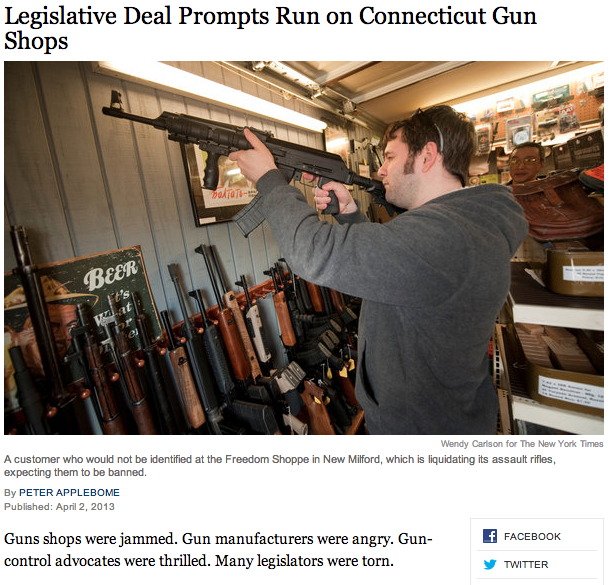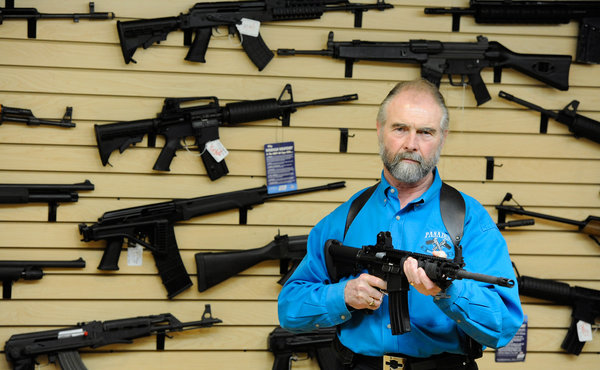
Last month, I noted an article by The New York Times‘ Sabrina Tavernise and Robert Gebeloff, in which the two reported a long-term, steady decrease in gun ownership. They explained:
The findings contrast with the impression left by a flurry of news reports about people rushing to buy guns and clearing shop shelves of assault rifles after the massacre last year at an elementary school in Newtown, Conn.
“There are all these claims that gun ownership is going through the roof,” said Daniel Webster, the director of the Johns Hopkins Center for Gun Policy and Research. “But I suspect the increase in gun sales has been limited mostly to current gun owners. The most reputable surveys show a decline over time in the share of households with guns.”
In my post, after providing three examples of recent Times articles (here, here, and here) that had noticeably contributed to the aforementioned “flurry of news reports” about people rushing to buy guns, I concluded:
One can be forgiven for reading The New York Times and leaving with the impression that, yes, the entire country is stampeding its nearest weapons shops and loading up on anything with a trigger. This is just the latest in a long line of examples of the media helping to create a story, then reporting on the fallout from that story from a detached perspective, as if the press had nothing to do with the preceding whirlpool of artificially manufactured “news” in the first place.
Well, as you can see above, the Times has yet to lose its appetite for stories about panicked weapons rushes:
Guns shops were jammed. Gun manufacturers were angry. Gun-control advocates were thrilled. Many legislators were torn.
But as President Obama on Tuesday announced a visit to Connecticut next week in the wake of an agreement on a far-ranging package of state gun legislation, Connecticut was bracing for the consequences, intended or not.
The most immediate result of the agreement, which came more than three months after the massacre of 26 children and educators in Newtown, was a run on gun shops on Tuesday, following months of already brisk sales. Gun owners are rushing to buy weapons, ammunition and magazines in anticipation of limits on their sale and possession.
…
Vic Benson, co-owner of the Freedom Shoppe, a gun shop in New Milford, said that his store was not usually even open on Tuesday, but that he opened its doors in anticipation of panicked buyers, and also to get rid of inventory he thinks he will be unable to sell after lawmakers vote on Wednesday.
The only indication in this entire article that all is not as depicted is the muted phrase “Gun owners are rushing…” — meaning that it is current owners, and not prospective gun buyers, that are leading the proverbial charge.
Look, the point isn’t that the Times shouldn’t cover news. And to some extent, delirious gun enthusiasts rushing their nearest weapons depot for a recharge so they can continue to shoot their high-powered guns with impunity even after stricter gun control legislation is passed is news.
Nevertheless, I would venture to guess that the Times‘ venerable voice is not well-utilized by devoting significant space in at least four articles in just over three months to the wildly exaggerated fears of armed paranoiacs. Perhaps, for example, some of those column inches could go towards additional coverage of shooting victims. Or of car dealerships, baseball, or whatever. After awhile, one starts to get the point: a lot of people love guns, and the Times is all over it.
But the larger point is that it’s ludicrous to continue covering these gun shop rushes on the one hand, while simultaneously remarking — as Tavernise and Gebeloff did — on the misleading “impression left by a flurry of news reports about people rushing to buy guns and clearing shop shelves of assault rifles,” as if the Times itself had nothing to do with creating this perception.
This paradox is especially concerning precisely because of what Tavernise and Gebeloff point out: gun ownership is decreasing. So publishing article after article portraying gun shops as overwhelmed by the demand for their products not only makes for boring reading, but doesn’t really present an accurate picture either.








